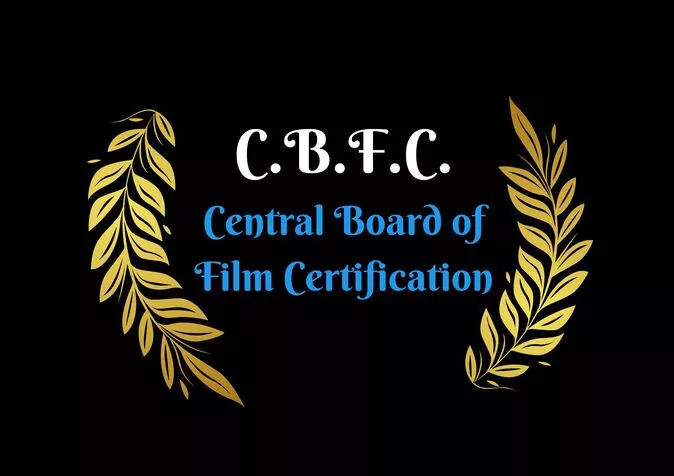Central Board of Film Certification (CBFC): Shaping Indian Cinema
The Central Board of Film Certification (CBFC), established under the Ministry of Information and Broadcasting, is the statutory body that regulates the public exhibition of films in India.
With its primary objective being the classification of films based on their content, the CBFC plays a vital role in safeguarding the interests of viewers, particularly children and young adults, and ensuring responsible filmmaking practices.
The mission of CBFC is to ensure good and healthy entertainment in accordance with the provisions of the Cinematograph Act 1952 and the Cinematograph (Certification) Rules 1983.
C.B.F.C. (At a Glance)
| Origination | 15 January 1951 (74) Years Ago |
| Motive | Film Certification |
| Parent organisation | Ministry of Information and Broadcasting (India) |
| Present Chairman | Prasson Joshi |
| Name of Chairpersons | List of Chairpersons |
| Organisation Structure | Organisation Chart |
| Members | List of Board Members |
| Website | CBFC India |
History and Evolution
Originally known as the Central Board of Film Censors, the CBFC was founded in 1951, shortly after India gained independence. In 1983, it was rebranded as the Central Board of Film Certification to emphasize its role in certifying films for public exhibition. Over the years, the CBFC has adapted to the changing landscape of the Indian film industry, striving to strike a balance between creative freedom and societal sensitivities.
Functions and Responsibilities
The CBFC performs various functions to regulate the public exhibition of films in India. These include:
Film Classification
The CBFC classifies films into various categories, such as U (Unrestricted Public Exhibition), U/A (Parental Guidance), A (Adults Only), and S (Special Class) based on their content and suitability for different age groups.
Content Censorship
The CBFC examines films for content that may be harmful or unsuitable for some particular audiences, particularly children and young people. It ensures that films adhere to ethical standards, respecting cultural values and societal norms.
Approval for Exhibition
After evaluating the content and classifying the film, the CBFC grants a certificate that permits the film’s public exhibition. This certification is a significant step in ensuring that submitted films meet the necessary standards and guidelines.
Appeals and Dispute Resolution
Filmmakers have the right to appeal against the CBFC’s decisions. The Film Certification Appellate Tribunal (FCAT) is an independent body to review and resolve appeals. Thus, FCAT provides an avenue for fair judgment and recourse.
Classification System and Guidelines
The CBFC employs a comprehensive classification system to categorize films based on their content. This system serves as a guiding framework for filmmakers and viewers. The guidelines consider factors such as violence, sex, language, and cultural sensitivities when determining the appropriate classification for a film.
By providing clear age-based classifications, the CBFC helps viewers make informed choices about the films they watch. CBFC also addresses concerns regarding content suitability.
The CBFC uses a four-tier classification system to classify films:
U (Unrestricted Public Exhibition)
U/A (Unrestricted Public Exhibition with an endorsement that it is necessary to caution that the question as to whether any child below the age of twelve (12) years may be allowed to see the film should be considered by the parents or guardians of such child.)
A (Public exibition restricted to adults)
S (Public exibition restricted to members of any profession or any class of person)
Challenges and Adaptation
The CBFC faces a range of challenges in an ever-evolving film landscape. The emergence of online streaming platforms has raised concerns about unregulated content, as these platforms may bypass the CBFC’s certification process. The CBFC is working towards establishing guidelines for digital content, ensuring that it aligns with the same principles applied to traditional film releases.
Furthermore, the CBFC grapples with the task of navigating social and cultural norms. As society progresses, perceptions of acceptability change, requiring the CBFC to be responsive and adaptable to new perspectives while upholding its commitment to responsible certification.
Looking Ahead: The Future of CBFC
As technology grows, the CBFC may face new challenges and opportunities. Virtual reality (VR), augmented reality (AR), and other emerging technologies pose unique certification dilemmas.
The CBFC will need to adapt and develop mechanisms to assess and certify content created for these platforms, ensuring that it remains appropriate and safe for the intended audience.
In 2023, CBFC introduced a new and unique search portal, which is easy to use comparatively. On this new search portal, one can find even recent unreleased movies for which CBFC has issued Censor Certificate.
The new CBFC film search portal is user-friendly and gives an opportunity to go public to know the rating of a particular film before watching it.
As the central authority overseeing film certification in India, the CBFC plays a critical role in shaping the cinematic terrain of the country.
The CBFC, with its classification system and guidelines, aims to balance artistic expression with societal responsibilities, ensuring that films are entertaining and mindful of diverse audience sensibilities.
With the ever-changing dynamics of the film industry, the CBFC continues to evolve, adapting to new challenges and technologies while upholding its core mission of responsible film certification.
Note: In case any clarifict

